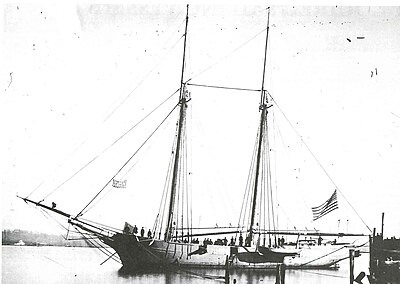 |
| Mortar Boat |
The Federals began their attack with a bombardment from Porter's mortar boats. They opened on April 18th and began firing steadily for the next few days. The mortars were a failure. Porter at thought the boats would complete their work in 48 hours, but in six they had not finished their work. The big shells at first scared the garrison, but they soon realized that although terrifying, the projectiles caused few casualties and little serious damage. The mortar crews themselves had even harder work, with the terrible concussion of firing the huge mortars every few minutes. The fire was finally stopped as the mortar crews were completely worn out, and it seemed useless to continue.
 |
| Mortar Boat |
With the first part of the plan having failed, Farragut decided to try with his wooden ships. He had sent two of his ships forward, and they had been able to open a gap in the chain boom across the river. The ships would advance in two columns and when the forts opened fire, they would answer them, but their main focus would be to get past them as fast as possible. In preparing the ships chains were brought up to cover the critical parts, protecting them from Confederate shot, fire brigades were trained and the ships were covered with mud so that they could advance as far as possible without being seen. As was customary in sea battles, the decks were covered in sand so that the sailors would not slip in their comrade's blood.
The fleet set off at 2 am on April 24th, 150 years ago today. They were undetected until they reached the boom. At that moment the forts opened on the ships with tremendous noise, and the Federal ships soon replied. "Imagine all the earthquakes in the world, and all the thunder and lightnings together in a space of two miles, all going off at once." Farragut said the bombardment was "as if the artillery of heaven were playing upon earth." Farragut's ships were sucessfully making it through the gap in the chain, but they suffered under the fire from the forts. John Bartlet captain of the Brooklyn, wrote,
"As we came to the obstruction the water-battery on the Fort Jackson side opened a most destructive fire, and here the Brooklyn received her first shot. We gave the water-battery a broadside of grape. With our own smoke and the smoke from the vessels immediately ahead, it was impossible to direct the ship, so that we missed the opening between the hulks and brought up on the chain. We dropped back and tried again; this time the chain broke, but we swung alongside of one of the hulks, and the stream-anchor, hanging on the starboard quarter, caught, tore along the hulk, and then parted its lashings. The cable secured us just where the Confederates had the range of their guns, but somebody ran up with an axe and cut the hawser, and we began to steam up the river. ... There were many fire-rafts, and these and the flashing of the guns and bursting shells made it almost as light as day, but the smoke from the passing fleet was so thick that at times one could see nothing ten feet from the ship. While entangled with the rafts, the Brooklyn was hulled a number of times; one shot from Fort Jackson struck the rail just at the break of the poop and went nearly across, plowing out the deck in its course. Another struck Barney Sands, the signal quartermaster, and cut his body almost in two."The Confederates were launching fire rafts, attempting to set the wooden vessels on fire. The flag ship ran aground, and a fire ship rammed into her. For a few minutes it appeared, that Farragut, the ship, and the entire crew would be engulfed in flames, but the crew was finally able to blow up the fire raft and get the ship afloat.



0 comments:
Post a Comment